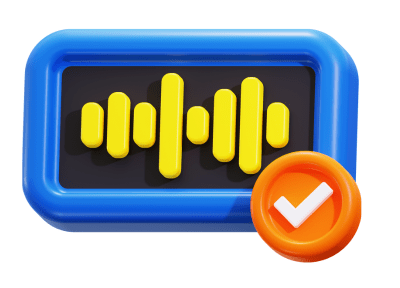
Ensuring Audio Quality Assurance in the gaming industry
Your character Ronan, old, reliable, battle-worn ranger Ronan, walks into a dense, moonlit forest. With every step he takes, fallen leaves crunch while an owl announces its presence with a distant hoot. His leather armour creaks subtly as he delves deeper into the mysterious forest. Suddenly, the ambient hum of the woods is replaced by an eerie stillness. Ronan’s heartbeat begins to pound in his ears. With a sharp inhale, he calms down as he has prepared all his life for what’s to come: the wind echoes the sound of a razor-sharp blade being drawn – he knows his enemy is near…
In today’s video game landscape, immersive experiences that sell credible stories could differentiate you. Therefore, only visualising the characters is not enough for a complete game experience: you need to understand their struggles, their intentions and unravel the game’s universe and connect with the storyline. To provide such a complex experience, developers must invest in high-quality sound.
Audio Quality Assurance (AQA) in the gaming industry ensures that every sound component – from ambient noises to voiceovers – meets the highest standards before a game reaches its audience.
Why is AQA essential in the gaming industry?
Walter Murch, a renowned film editor and sound designer, made a very famous and essential observation on the dependency that a movie experience has on high-quality audio, famously stating that “sound is 50% of the experience of a film.”
From this point of view, the film and video game industries are much alike. In some ways audio should never be noticed by the player, it should be so seamless that it becomes like sound in real life, it’s just accepted. On one hand, high-quality audio matters because it does much more than simply complement the visual cues: it enhances the entire experience. High-quality audio can significantly increase the immersive attribute of any game, further adding to its credibility and storyline and even pushing the player to emphasise the game’s universe further. The flip side is that poor audio quality can significantly disrupt or distract the players experience. Whether it’s a distorted sound or even an unrealistic depiction of reality transposed in the game, poor audio quality can compromise the intended game experience.

On the other hand, audio is a very effective narrative tool, as many games rely on a ‘narrator’ who tells the story from a detached, third-person point of view. If this voice comes from a well-prepared actor who connects with the storyline, and if that convincing interpretation is enriched by the right sound effects, then players’ emotional attachment to the storyline will increase. As previously, the same goes for poor narrative interpretation – it distracts players from the original storyline
What are AQA’s unique challenges?
Like any other part of the game testing process, audio quality assurance has a couple of specific queries that need our testers’ full attention. Testing multi-channel audio in games is challenging because sound must be accurately positioned and balanced across different speaker setups, from basic headphones to advanced surround sound systems. QA teams must ensure there are no distortions or issues across all devices, for both low- and high-end audio setups.
In addition, different platforms handle audio differently. Optimizing a game’s audio package on PC can differ a lot from starting the same process on consoles or mobile devices, so game testers must make sure to thoroughly understand the audio universe from each platform, and that the game audio plays correctly across all devices without delays, distortions, or compatibility problems with different sound hardware.

Another interesting and unique aspect of audio testing that adds quality to the gamers’ experience is the process of localized voiceover testing. Around the globe, there is a huge variety of cultures and language, so the teams need to make sure that the voiceovers are translated correctly and moreover, that they sound just as convincing and personal as the original interpretations. This process requires lots of patience and care as testers must ensure accurate translations, proper timing, and high-quality sound in each version.
Developing audio for a whole virtual world is already complex enough, as audio engineers often have to simulate real-world acoustics to adapt the sound to different environments. For example, an outdoor confrontational scene in an open field has a certain sound from the same confrontational scene taking place in an abandoned bar, even if the characters and weapons are alike, only because the acoustics differ. Further on, as game testers, we need to verify that these acoustics respond correctly within the gameplay, avoiding anomalies like echo issues or unbalanced ambient sound.
Even more, some games use adaptive music, also known as dynamic or interactive music. This type of background music changes its volume, rhythm, or melody in response to specific in-game events. Games like Doom, Doom Eternal, Metal Gear Rising, and Roboquest utilized this technique to enhance the player’s experience, making the music feel more immersive, appropriate and reactive to gameplay. This is also another aspect that needs to be thoroughly explored before the game launches.
What should game testers keep in mind regarding AQA?
After almost 2 decades of experience in the game testing industry, Quantic Lab’s team have developed a set of best practices that assure us and our partners that we provide thorough and effective AQA.
The first steps begin even before testing. We usually make our teams aware of the crucial importance of establishing detailed specifications for audio standards, including decibel levels, bitrates, channel configurations, and latency tolerance. Having a standardized procedure helps us to maintain fair comparisons and ensures that tests produce consistent, accurate results across different setups.

At the beginning of any AQA process, our game testers conduct automated audio tests in order to check for consistency in performance across platforms. However, manual testing is also necessary, because it focuses on human-related aspects of the game that automatic tests cannot cover. A good example of when manual testing is necessary is in the case of subjective audio quality when testers make sure that the dialogue matches the emotional tone of a scene.
After these initial procedures, we turn to the localization aspect. As we mentioned before, this meticulous process ensures that translated voiceovers and sound effects maintain their original meaning and their high audio quality. This involves checking for timing accuracy, lip sync (ensuring character speech matches mouth movements) and sound effect localization (adapting sounds to fit different languages or regions).
We usually continue by checking audio’s availability and accuracy across various platforms. This process sometimes involves outside-office testing, as different-quality speakers can sound differently in quiet versus loud places. As game testers, we must ensure that players hear the game properly at all times.
Last but not least, audio should be tested at every stage of development, not just at the end. Regular testing helps find problems early, preventing expensive last-minute fixes.
What tools are useful for AQA?
Besides the series of good practices, we also make the best use of technological tools that can streamline and enhance the audio testing process. Some relevant examples include:
– Wwise: A comprehensive audio middleware solution for dynamic audio integration and real-time testing.
– FMOD: Another popular audio engine that helps automate testing for complex audio events and surround sound.
– Loudness Meters: Tools like Nugen Audio or iZotope RX that ensure consistent volume levels across different audio channels.
– Subjective Listening Tests: Teams should employ focus groups and individual testers to listen to audio for clarity, balance, and quality.
We hope that by the end of this article, you gained more clarity about what the audio quality assurance process contains and how to navigate through every challenge that might appear. And remember, in most cases, even the first audio samples can shape the overall player experience.
